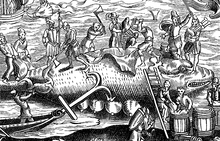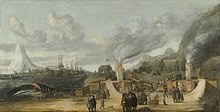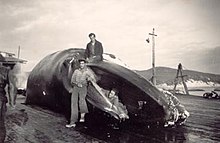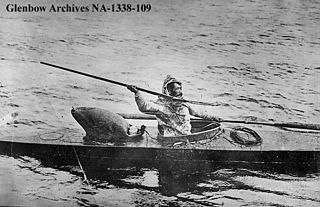
A harpoon is a long spear-like projectile used in fishing, whaling, sealing, and other hunting activities to shoot, kill, and capture large fish or marine mammals such as seals, sea cows and whales. It accomplishes its task by impaling the target animal and securing it with barb or toggling claws, allowing the fishermen or hunters to use an attached rope or chain to pull and retrieve the animal. A harpoon can also be used as a ranged weapon against other watercraft in naval warfare.
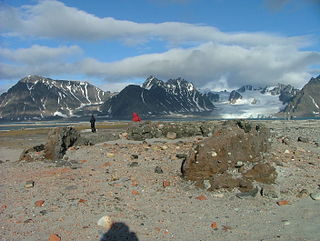
Smeerenburg was a whaling settlement on Amsterdam Island in northwest Svalbard. It was founded by the Danish and Dutch in 1619 as one of Europe's northernmost outposts. With the local bowhead whale population soon decimated and whaling developed into a pelagic industry, Smeerenburg was abandoned around 1660.
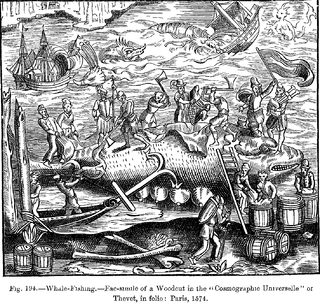
This article discusses the history of whaling from prehistoric times up to the commencement of the International Whaling Commission (IWC) moratorium on commercial whaling in 1986. Whaling has been an important subsistence and economic activity in multiple regions throughout human history. Commercial whaling dramatically reduced in importance during the 19th century due to the development of alternatives to whale oil for lighting, and the collapse in whale populations. Nevertheless, some nations continue to hunt whales even today.

Drawing Restraint 9 is a 2005 film project by visual artist Matthew Barney consisting of a feature-length film, large-scale sculptures, photographs, drawings, and books. The Drawing Restraint series consists of 19 numbered components and related materials. Some episodes are videos, others sculptural installations or drawings. Barney created Drawing Restraint 1-6 while still an undergraduate at Yale University and completed Drawing Restraint 16 in 2007 at London's Serpentine Gallery. With a soundtrack composed by Björk, Drawing Restraint 9 is an unconventional love story set in Japan. The narrative structure is built upon themes such as the Shinto religion, the tea ceremony, the history of whaling, and the supplantation of blubber with refined petroleum for oil.
Whale oil is oil obtained from the blubber of whales. Oil from the bowhead whale was sometimes known as train-oil, which comes from the Dutch word traan.

A whaler or whaling ship is a specialized vessel, designed or adapted for whaling: the catching or processing of whales.
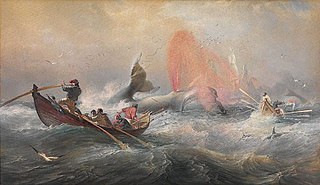
Whaling in Australian waters began in 1791 when five of the 11 ships in the Third Fleet landed their passengers and freight at Sydney Cove and then left Port Jackson to engage in whaling and seal hunting off the coast of Australia and New Zealand. The two main species hunted by such vessels in the early years were right and sperm whales. Humpback, bowhead and other whale species would later be taken.
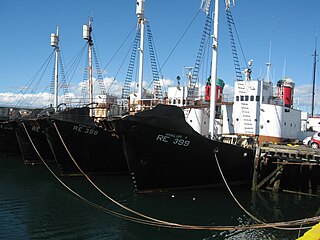
Whaling in Iceland began with spear-drift hunting as early as the 12th century, and continued in a vestigial form until the late 19th century, when other countries introduced modern commercial practices. Today, Iceland is one of a handful of countries that formally object to an ongoing moratorium established by the International Whaling Commission in 1986, and that still maintain a whaling fleet. One company remains concentrated on hunting fin whales, largely for export to Japan, while the only other one previously hunted minke whales for domestic consumption until 2020, as the meat was popular with tourists. In 2018, Hvalur hf whalers killed a rare blue whale/fin whale hybrid.
Whaling in Norway involves hunting of minke whales for use as animal and human food in Norway and for export to Japan. Whale hunting has been a part of Norwegian coastal culture for centuries, and commercial operations targeting the minke whale have occurred since the early 20th century. Some still continue the practice in the modern day, within annual quotas.
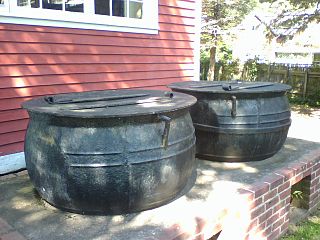
A try pot is a large pot used to remove and render the oil from blubber obtained from cetaceans and pinnipeds (seals), and also to extract oil from penguins. Once a suitable animal such as a whale had been caught and killed, the blubber was stripped from the carcass in a process known as flensing, cut into pieces, and melted in the try pots to extract the oil.

Commercial whaling in the United States dates to the 17th century in New England. The industry peaked in 1846–1852, and New Bedford, Massachusetts, sent out its last whaler, the John R. Mantra, in 1927. The Whaling industry was engaged with the production of three different raw materials: whale oil, spermaceti oil, and whalebone. Whale oil was the result of "trying-out" whale blubber by heating in water. It was a primary lubricant for machinery, whose expansion through the Industrial Revolution depended upon before the development of petroleum-based lubricants in the second half of the 19th century. Once the prized blubber and spermaceti had been extracted from the whale, the remaining majority of the carcass was discarded.

Sperm whaling is the human practice of hunting sperm whales, the largest toothed whale and the deepest-diving marine mammal species, for the oil, meat and bone that can be extracted from the cetaceans' bodies.
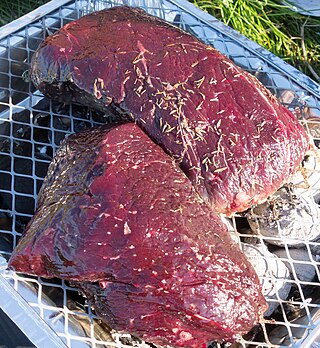
Whale meat, broadly speaking, may include all cetaceans and all parts of the animal: muscle (meat), organs (offal), skin (muktuk), and fat (blubber). There is relatively little demand for whale meat, compared to farmed livestock. Commercial whaling, which has faced opposition for decades, continues today in very few countries, despite whale meat being eaten across Western Europe and colonial America previously. However, in areas where dolphin drive hunting and aboriginal whaling exist, marine mammals are eaten locally as part of a subsistence economy: the Faroe Islands, the circumpolar Arctic, other indigenous peoples of the United States, St. Vincent and the Grenadines, some of villages in Indonesia and in certain South Pacific islands.

Jūrō Oka was a Japanese businessman considered the "father of Japanese whaling".
The Basques were among the first people to catch whales commercially rather than purely for subsistence and dominated the trade for five centuries, spreading to the far corners of the North Atlantic and even reaching the South Atlantic. The French explorer Samuel de Champlain, when writing about Basque whaling in Terranova, described them as "the cleverest men at this fishing". By the early 17th century, other nations entered the trade in earnest, seeking the Basques as tutors, "for [they] were then the only people who understand whaling", lamented the English explorer Jonas Poole.

Voe is a settlement on the Northmavine peninsula of Mainland, Shetland, Scotland. It is at the head of Ronas Voe and just off the A970 road.
Thomas Welcome Roys was an American whaleman. He was significant in the history of whaling in that he discovered the Western Arctic bowhead whale population and developed and patented whaling rockets in order to hunt the faster, more powerful species that had until then eluded European whalers.

Commercial whaling in Britain began late in the 16th century and continued after the 1801 formation of the United Kingdom and intermittently until the middle of the 20th century.

A drift whale is a cetacean mammal that has died at sea and floated into shore. This is in contrast to a beached or stranded whale, which reaches land alive and may die there or regain safety in the ocean. Most cetaceans that die, from natural causes or predators, do not wind up on land; most die far offshore and sink deep to become novel ecological zones known as whale falls. Some species that wash ashore are scientifically dolphins, i.e. members of the family Delphinidae, but for ease of use, this article treats them all as "drift whales". For example, one species notorious for mass strandings is the pilot whale, also known as "blackfish", which is taxonomically a dolphin.

Whaling on the Pacific Northwest Coast encompasses both aboriginal and commercial whaling from Washington State through British Columbia to Alaska. The indigenous peoples of the Pacific Northwest Coast have whaling traditions dating back millennia, and the hunting of cetaceans continues by Alaska Natives and to a lesser extent by the Makah people.

